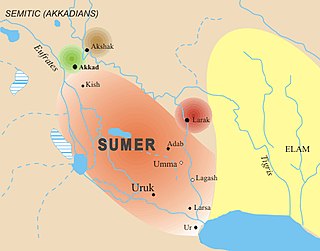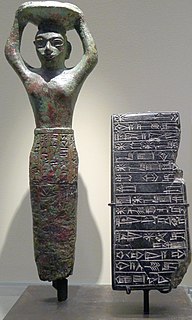Related Research Articles
The 1740s BC was a decade lasting from January 1, 1749 BC to December 31, 1740 BC.

Samsu-iluna was the seventh king of the founding Amorite dynasty of Babylon, ruling from 1750 BC to 1712 BC, or from 1686 to 1648 BC. He was the son and successor of Hammurabi by an unknown mother. His reign was marked by the violent uprisings of areas conquered by his father and the abandonment of several important cities.

Puzur-Inshushinak, also sometimes thought to read Kutik-Inshushinak in Elamite, was king of Elam, around 2100 BC, and the last from the Awan dynasty according to the Susa kinglist. He mentions his father'name as Šimpi-išhuk, which, being an Elamite name, suggests that Puzur-Inshuhinak himself was Elamite.

Puzer-Mama or Puzur-Mama was a ruler of Lagash before Gudea, circa 2200 BCE. Though he adopted the title of King (lugal), Puzer-Mama shows kinship with future Lagashite kings in the religiosity of his inscriptions.

Amar-Sin, initially misread as Bur-Sin was the third ruler of the Ur III Dynasty. He succeeded his father Shulgi. His name translates to 'immortal moon-god'.

The Awan Dynasty was the first dynasty of Elam of which very little of anything is known today, appearing at the dawn of historical record. The Dynasty corresponds to the early part of the Old Elamite period, it was succeeded by the Shimashki Dynasty and later the Sukkalmah Dynasty. The Elamites were likely major rivals of neighboring Sumer from remotest antiquity; they were said to have been defeated by Enmebaragesi of Kish, who is the earliest archaeologically attested Sumerian king, as well as by a later monarch, Eannatum I of Lagash.

Akshak was a city of ancient Sumer, situated on the northern boundary of Akkad, sometimes identified with Babylonian Upi. Its exact location is uncertain. Classical writers located it where the Tigris and Euphrates rivers are closest together and it was mentioned along with Kish in early records. Archaeologists in the 1900s placed Akshak at the site of Tel Omar where a pair of sites straddles the Tigris, but that turned out to be Seleucia when it was excavated by LeRoy Waterman of the American Schools of Oriental Research, though a fragment with the name Akshak was found there. Michael C. Astour placed it on the Tigris, on what is now the southern outskirts of Baghdad.
Aššur-nārāri I, inscribed maš-šur-ERIM.GABA, "Aššur is my help," was an Old Assyrian king who ruled for 26 years during the mid-second millennium BC, c. 1547 to 1522 BC. He was the 60th king to be listed on the Assyrian Kinglist and expanded the titles adopted by Assyrian rulers to include muddiš, "restorer of," and bāni, "builder of," to the traditional epithets ensi, "governor," and iššiak, "vice-regent," of Aššur.
Puzur-Ashur II was the king of the Old Assyrian Empire c. 1880 to 1873 BC. Puzur-Ashur II had been both the son and successor of Sargon I. Due to Sargon I's long reign, Puzur-Ashur II came to the throne at a late age since one of his sons, named Ili-bani, was a witness in a contract eleven years before Puzur-Ashur II became ruler. Puzur-Ashur II was succeeded by his son Naram-Sin. The following is a list of the nine annually-elected "limmu" ("eponym") officials from the year of accession of Puzur-Ashur II, the "waklum" ("overseer"), in the limmu of Ashur-iddin to Puzur-Ashur II's death in the limmu of Inaya BC dates are based on a date of 1833 BC for the recorded solar eclipse in the limmu of Puzur-Ištar:
ErishumI or Erišum II, the son and successor of Naram-Sin, was the king of the city-state Assur from c. 1828/1818 BC to 1809 BC. Like his predecessors, he bore the titles “Išši’ak Aššur” and “ensí”. The length of Erishum II's reign is uncertain, however; based on various excavated "limmu" (eponym) lists, Naram-Sin's and Erishum II's reigns had a combined length of 64 years.

The Old Assyrian Empire (Sumero-Akkadian cuneiform: 𒆳𒀭𒊹𒆠 KUR AN-ŠAR2KI, Assyrian cuneiform: mat aš-šur KI, "Country of the city of god Aššur"; also phonetically mat da-šur) is the second of four periods into which the history of Assyria is divided, the other three being the Early Assyrian Period (2600–2025 BC), the Middle Assyrian Empire (1392–934 BC), and the Neo-Assyrian Empire (911–609 BC). Assyria was a major Mesopotamian East Semitic-speaking kingdom and empire of the ancient Near East. Centered on the Tigris–Euphrates river system in Upper Mesopotamia, the Assyrian people came to rule powerful empires at several times. Making up a substantial part of the "cradle of civilization", which included Sumer, the Akkadian Empire, and Babylonia, Assyria was at the height of technological, scientific and cultural achievements at its peak.
Naram-Sin, or Narām-Sîn or –Suen, inscribed in cuneiform on contemporary seal impressions as dna-ra-am-dEN.ZU, had been the "waklum" or "Išši’ak Aššur" of the city-state Assur, listed as the 37th king of Assyria on the later Assyrian King Lists, where he is inscribed mna-ram-dEN.ZU, or a fragmentary list where he appears as -d30. He was named for the illustrious Naram-Sin of Akkad and took the divine determinative in his name Naram-Sin should not be confused with the Naram-Sin who had ruled Eshnunna for around twelve years It is probable that Naram-Sin of Assur was, however, contemporaneous with the earlier part of Ebiq-Adad II’s reign Naram-Sin of Assyria was the son and successor of the short-reigning Puzur-Ashur II, filiation preserved in his seal impression on the envelopes of the waklum-letters to his expat Anatolian-based traders at the karum Kanesh and in the later Assyrian King Lists.

Ishbi-Erra was the founder of the dynasty of Isin, reigning from c. 2017 — c. 1986 BC on the middle chronology or 1953 BC — c. 1920 BC on the short chronology. Ishbi-Erra was preceded by Ibbi-Sin of the third dynasty of Ur in ancient Lower Mesopotamia, and then succeeded by Šu-ilišu. According to the Weld-Blundell Prism, Išbi-erra reigned for 33 years and this is corroborated by the number of his extant year-names. While in many ways this dynasty emulated that of the preceding one, its language was Akkadian as the Sumerian language had become moribund in the latter stages of the third dynasty of Ur.
Aššūr-dugul, inscribed maš-šur-du-gul, “Look to Aššur!”, was the king of Assyria probably during the 18th century BC, a period of confusion in Assyrian history. Reigning for six years, he was the 44th ruler to be listed on the Assyrian Kinglist, and was designated by the list as a usurper succeeding the dynasty founded by Shamshi-Adad I.
Puzur-Ashur I was an Assyrian king in the 21st and 20th centuries BC. He is generally regarded as the founder of Assyria as an independent city-state, c. 2025 BC.
Puzur-Sin was an Assyrian ruler who was responsible for driving out Asinum the Amorite vassal king of the Babylonians from Assyria, and allowing the native Ashur-dugul to seize the throne.

Rimush or Rīmu[š], inscribed mri-mu-u[š] on the only variant List of Assyrian kings on which he appears, was the ruler of Assyria or perhaps just the part centered on Ekallatum, a successor to and probably a descendant of Shamshi-Adad I, although the exact relationship is uncertain. He reigned sometime during the middle of the 18th century BC.
The Correspondence of the Kings of Ur (CKU), also known as the Royal Correspondence of Ur, is a collection of 24 literary letters written in the Sumerian language and attributed to kings of the Ur III period, 2048–1940 BCE. They are known primarily from copies dating to the Old Babylonian period, ca. 1800–1600 BCE; their original date of composition and their historical accuracy are debated.
Hanun-Dagan, was the Shakkanakku and king (Lugal) of Mari reigning c. 2008-2016 BC. He was the brother of his predecessor Hitlal-Erra, and is recorded as the son of Shakkanakku Puzur-Ishtar on a seal discovered in the city. Although the title of Shakkanakku designated a military governor, the title holders in Mari were independent monarchs, and nominally under the vassalage of the Ur III dynasty. Some Shakkanakkus used the royal title Lugal in their votive inscriptions, while using the title of Shakkanakku in their correspondence with the Ur's court, and it is certain that Hanun-Dagan used the royal title.
References
- ↑ Reade, J. E. (2001). "Assyrian King-Lists, the Royal Tombs of Ur, and Indus Origins". Journal of Near Eastern Studies. 60 (1): 1–29. doi:10.1086/468883. JSTOR 545577. S2CID 161480780.